E/E Architecture Research: How will the zonal EEA evolve and materialize from the perspective of supply chain deployment?
Through the lens of development trends, automotive EEA (Electronic/electrical Architecture) will eventually evolve to central computing architectures with functional logics centralized in one central controller. OEMs become ever more radical in EEA planning. For OEMs, the year of 2023- 2023 will be a key time node to mass-produce the next-generation “quasi-central computing + zone” architecture.
Evolution Trends of Automotive E/E Architecture in the Next 5- 10 Years
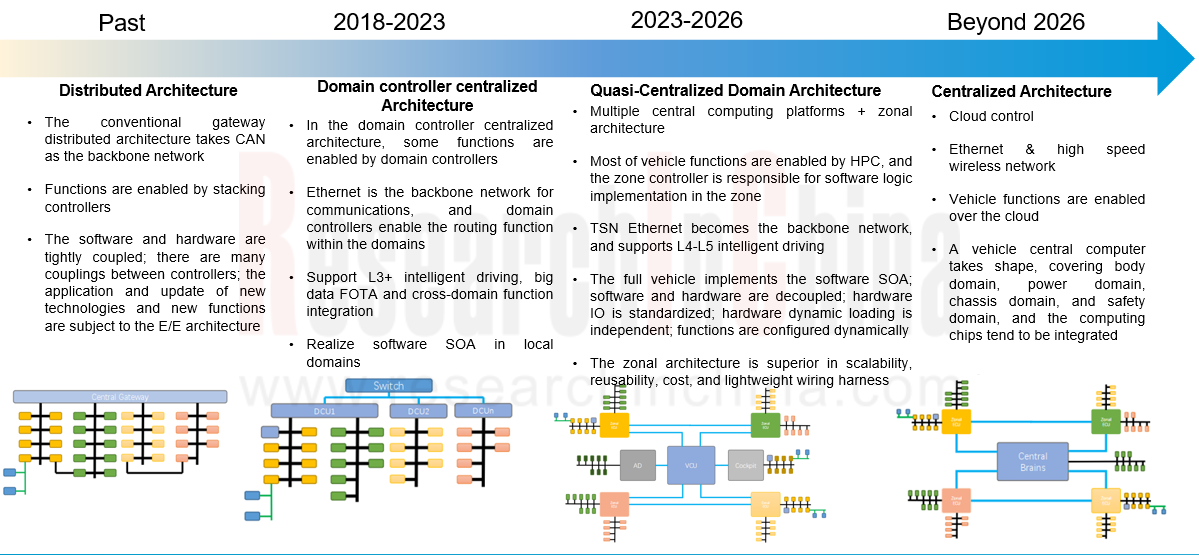
Source: ResearchInChina
The “quasi-central computing + zone” architecture can be further subdivided into many types:
 Body-zonal architecture: The controller of the body zone is connected to the central computing unit through the high-speed Ethernet backbone network, and the central computing unit integrates the functions like vehicle control, body control and gateways, simplifying the network topology, wiring harness layout and weight;
Body-zonal architecture: The controller of the body zone is connected to the central computing unit through the high-speed Ethernet backbone network, and the central computing unit integrates the functions like vehicle control, body control and gateways, simplifying the network topology, wiring harness layout and weight;
 X-domain zonal architecture: The functional zone is combined with the body zone, and the X-domain uses a more powerful processor unit, which can independently call the sensors in the zone and process data;
X-domain zonal architecture: The functional zone is combined with the body zone, and the X-domain uses a more powerful processor unit, which can independently call the sensors in the zone and process data;
 Software-defined vehicle (SDV) optimized architecture: With centralized and service-oriented computing, the central computer of vehicle has powerful processing capability and makes all decisions, while zonal controllers supply power and perform the instructions issued by the central control unit.
Software-defined vehicle (SDV) optimized architecture: With centralized and service-oriented computing, the central computer of vehicle has powerful processing capability and makes all decisions, while zonal controllers supply power and perform the instructions issued by the central control unit.
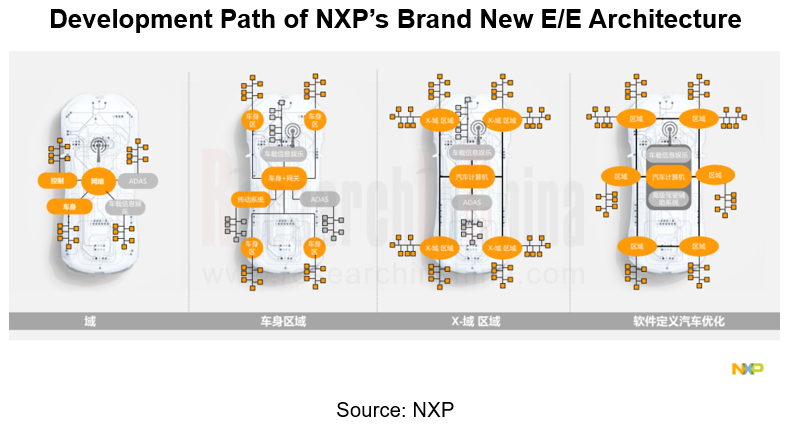
Under zonal architecture, MCUs tend to feature high performance and multi-core
In the future central integrated E/E architecture, the central processing unit communicates with zonal controllers through Ethernet, while zonal controllers communicate with sub-ECUs, sensors and actuators through CAN/LIN bus.
Physically, the zonal controllers logically concentrate multiple ECUs, proposing a higher requirement for the computing power of MCU in the zonal controllers. In the traditional ECUs with simple functions, a single-core MCUs with low performance are qualified, while zonal controllers often require multi-core MCUs. In a multi-core MCU, each core can run a single function, while multi-core can realize multiple functions, thus realizing the integration of multiple ECU functions.
 X-Soul Architecture of GAC Aion GA3.0
X-Soul Architecture of GAC Aion GA3.0
The newly-launched Hyper GT is the world's first model that uses NXP S32G3 as the central computing unit processor. The "central computing unit" developed by Continental adopts the latest "NXP S32G399 high-performance gateway computing chip". The basic middle layer of the software architecture of the front and rear zonal controllers adopts atomic service packaging and standardized interfaces, and the middle layer uses enhanced composite services and can be implemented independently.
 Xpeng’s X-EEA3.0
Xpeng’s X-EEA3.0
For the first time in China, it has attained a communication architecture with Gigabit Ethernet as the backbone and supports multiple communication protocols, making vehicle data transmission faster. The central computing unit and zonal controllers of X-EEA3.0 adopt Renesas’ flagship MCU based on the third-generation RXv3 CPU core. On the basis of X-EEA3.0, Xpeng G6 has further mass-produced and deployed the new Fuyao X-EEA3.5.
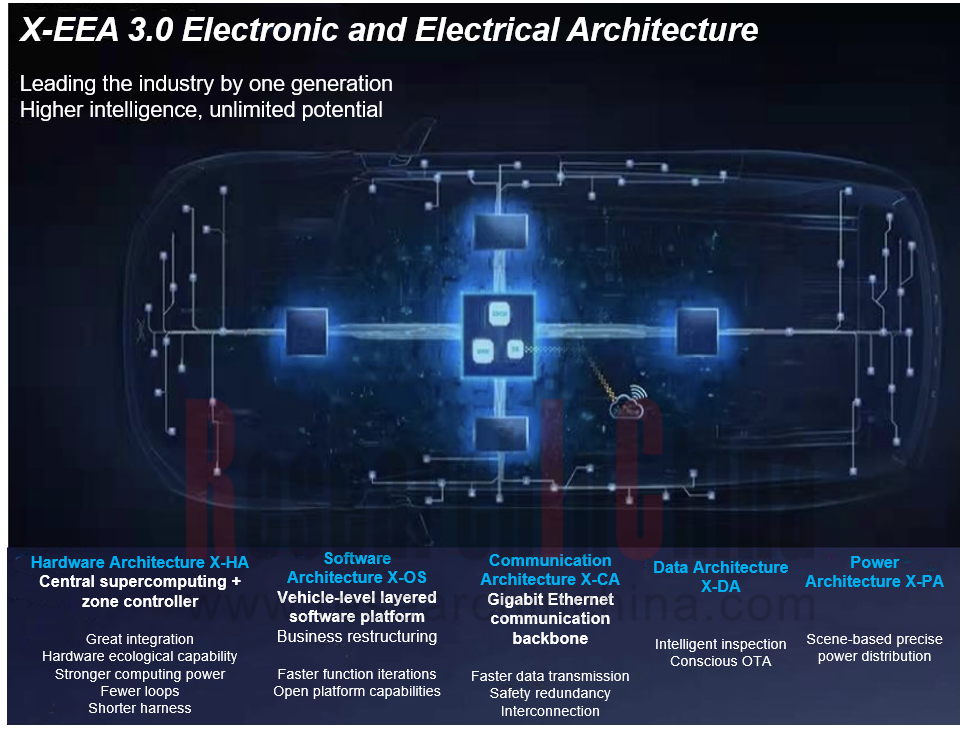
Source: Xpeng
 Infineon's 3rd-generation AURIX? TC4xx MCU
Infineon's 3rd-generation AURIX? TC4xx MCU
High-performance AURIX? TC4xx family mainly meets the new requirements of the central computing and zonal control. It is equipped with up to six TriCore? 1.8 embedded cores, each with a clock frequency of up to 500MHz; integrated with a PPU coprocessor, it can realize fast vector operation, basic neural network algorithms and other complex mathematical algorithms. In future regional controllers, PPU can be used in some information security algorithms for modeling, model predictive control, and anti-intrusion detection.
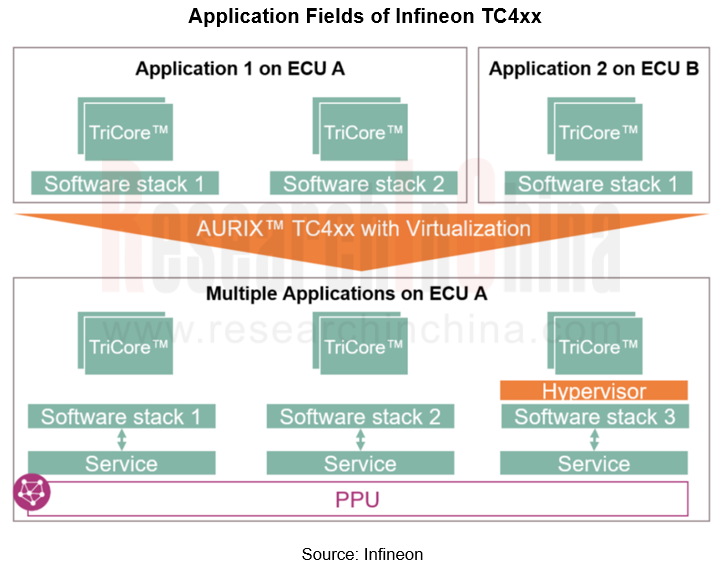
Under zonal architecture, the demand for automotive Ethernet PHY and switch chips soars, so that the price fluctuates sharply.
The interface circuit of automotive Ethernet is mainly composed of MAC controllers and PHY chips. In terms of integration method, embedded chip vendors generally integrate the MAC inside the MCU/CPU. For example, Infineon's AURIX integrates MAC into the main MCU, and also integrates CRE/DRE, the dedicated hardware communication routing module; whereas, the PHY chip is provided by the OEM or controller supplier as an independent chip.
The global Ethernet switch/PHY chip market size hit about USD800 million in 2023, and it is expected to reach USD2.5 billion in 2028. It is estimated that each car will use 2-4 Ethernet switch chips and 2-4 PHY chips on average by 2028.
Since 2023, the short-term price of some Ethernet PHY and switch chips of Broadcom BCM89 family has soared several times, with a single chip valued USD30-40. The BCM8955X family is Broadcom's third-generation automotive Ethernet switch solutions, which are mainly used in ADAS, infotainment systems and gateways. At present, Broadcom mainly promotes the BCM8957X family, which is the only automotive Ethernet switch in the world that supports the 802.3ch standard.
In a typical central computing + zonal architecture, each zonal gateway contains an Ethernet switch, and each vehicle requires at least 6-7 Ethernet switch chips. At present, Marvell, Broadcom, NXP and other automotive network communication chip vendors have proposed the next-generation network architecture.
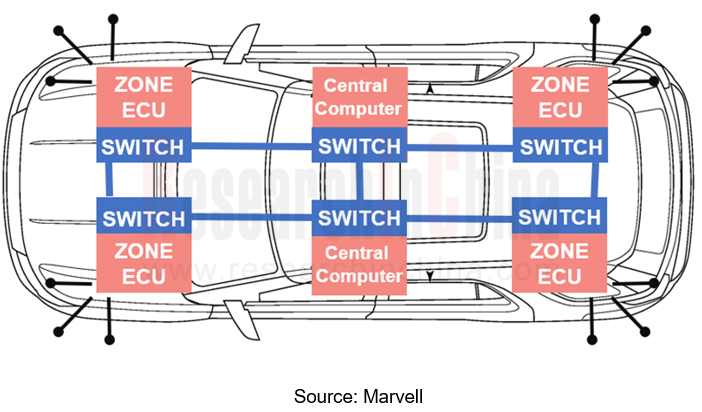
OEMs forecast that the central computing + zonal architecture will only come true in 2025 by virtue of 10G bandwidth. In June 2023, Marvell announced the Brightlane Q622x family of central Automotive Ethernet switches to support the zonal networking architectures of next-generation vehicles. Central Automotive Ethernet switches are high-bandwidth, high-performance devices optimized to coordinate data traffic between zonal switches, which aggregate traffic from devices located within a physical zone of a car like processors, sensors, actuators, storage systems and others.
In the 10 Gigabit automotive Ethernet chip market, only Marvell and Broadcom can provide 10G+ Ethernet switches.
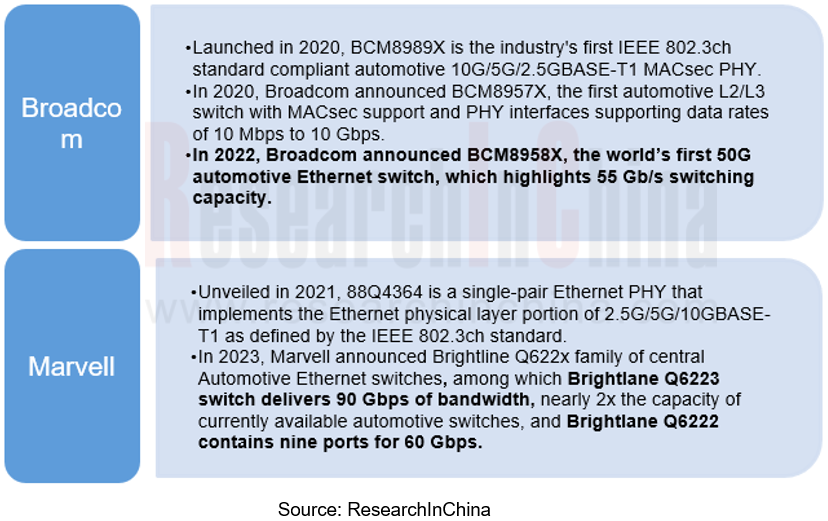
Under zonal architecture, the on-chip high-speed communication of central computer requires PCIe switches.
Driven by Chat GPT, the demand for AI servers has skyrocketed, and PCIe Switch chips represented by Broadcom SS26 are in shortage with the price swelling. In the next-generation E/E architecture, expensive PCIe switches are required by connection between multi-SoC cascade, SSD storage based on PCIe and the central SoC.
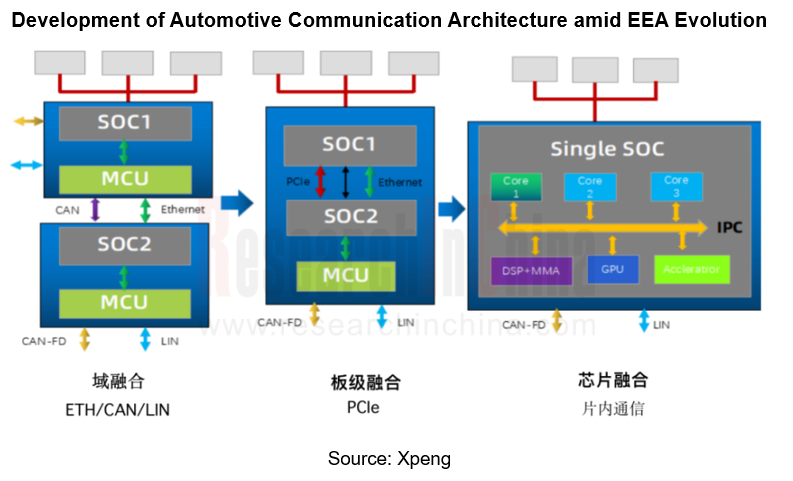
The cross-domain communication of automobiles will be based on PCIe, which can improve the communication efficiency to dozens of gigabytes compared with the previous Ethernet, and PCIe Switch enables the on-chip communication. Ethernet Switches are mounted on different SoCs in the central computing unit. The external sensors are connected in series through the Ethernet switches of zonal ECUs.
 Qualcomm's first-generation autonomous driving system, Ride3.0, uses PCIe switches in the automotive industry for the first time, that is, Microchip's PM43028B1-F3EI priced at about $100 dollars, higher than that of SA8155P and almost 4-5 times that of Ethernet switches.
Qualcomm's first-generation autonomous driving system, Ride3.0, uses PCIe switches in the automotive industry for the first time, that is, Microchip's PM43028B1-F3EI priced at about $100 dollars, higher than that of SA8155P and almost 4-5 times that of Ethernet switches.
 Visteon’s dual Qualcomm 8155 cockpit domain controllers are internally connected via the PCIe bus. Two 8155 SoCs are connected through PCle bus, with the transmission rate of 16Gbps, which can efficiently transmit the real-time video input of ADAS.
Visteon’s dual Qualcomm 8155 cockpit domain controllers are internally connected via the PCIe bus. Two 8155 SoCs are connected through PCle bus, with the transmission rate of 16Gbps, which can efficiently transmit the real-time video input of ADAS.
 SiEngine Technology has customized the high-speed interconnection bus SE-LINK for ECARX to realize the simultaneous operation of two "Longying No.1" chips. Two Antora 1000 platforms are connected to get Antora 1000 Pro. It can provide double computing power while maintaining the transmission speed, wherein the transmission speed of PCIe 3.0 Lane reaches 7.28 GT/s.
SiEngine Technology has customized the high-speed interconnection bus SE-LINK for ECARX to realize the simultaneous operation of two "Longying No.1" chips. Two Antora 1000 platforms are connected to get Antora 1000 Pro. It can provide double computing power while maintaining the transmission speed, wherein the transmission speed of PCIe 3.0 Lane reaches 7.28 GT/s.
EEA evolution drives the upheaval of underlying OS of vehicle
Adaptive AUTOSAR introduces the service-oriented architecture (SOA) and support for POSIX system, suitable for high-computing SoCs. SOA or the service-based middleware platform is also known as the automotive OS.
 The SOA of GAC's X-Soul architecture has realized standardized layered interfaces, software modularization, function atomization, remote function configuration and so on through the layered decoupled basic software architecture platform. GAC's X-Soul architecture is China's first product developed based on the ASF (AUTOSEMO Service Framework) technical specification. On the basis of the SOA, the GAC Rubik's Cube scenario co-creation platform has been mass-produced with GAC Aion Hyper GT.
The SOA of GAC's X-Soul architecture has realized standardized layered interfaces, software modularization, function atomization, remote function configuration and so on through the layered decoupled basic software architecture platform. GAC's X-Soul architecture is China's first product developed based on the ASF (AUTOSEMO Service Framework) technical specification. On the basis of the SOA, the GAC Rubik's Cube scenario co-creation platform has been mass-produced with GAC Aion Hyper GT.
 In April 2023, Huawei released the iDVP intelligent digital base, which is a SOA that allows zonal access and central computing. iDVP includes a hardware platform and a software platform. The hardware platform refers to the basic hardware platform of the computing and communication architecture, and the software platform includes an operating system, a basic management framework and a SOA software framework. In order to facilitate users to develop software on iDVP, Huawei has developed a supporting tool chain.
In April 2023, Huawei released the iDVP intelligent digital base, which is a SOA that allows zonal access and central computing. iDVP includes a hardware platform and a software platform. The hardware platform refers to the basic hardware platform of the computing and communication architecture, and the software platform includes an operating system, a basic management framework and a SOA software framework. In order to facilitate users to develop software on iDVP, Huawei has developed a supporting tool chain.
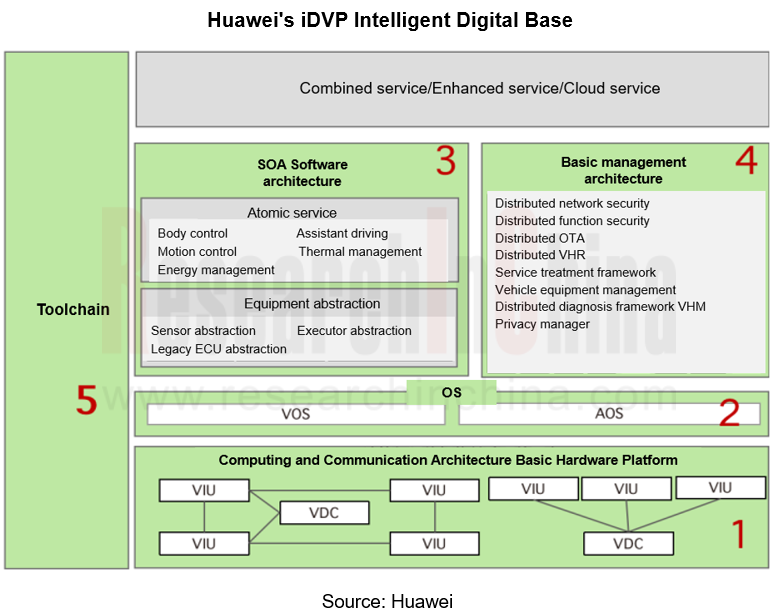
Automotive 4D Radar Industry Research Report 2025
4D radar research: From "optional" to "essential," 4D radar's share will exceed 50% by 2030.
1. 4D imaging radar has transformed from an "optional" to a "must-have" sensor.
4D radar adds the detecti...
China Automotive Multimodal Interaction Development Research Report, 2025
Research on Automotive Multimodal Interaction: The Interaction Evolution of L1~L4 Cockpits
ResearchInChina has released the "China Automotive Multimodal Interaction Development Research Report, 2025"...
Automotive Vision Industry Report, 2025
Automotive Vision Research: Average Camera Installation per Vehicle Reaches 5.2 Units, and Front-View Tricam Installation Exceeds 1.2 Million Sets.
From January to September 2025, the total installa...
Automotive Infrared Night Vision System Research Report, 2025
Automotive night vision research: The rise of infrared AEB, with automotive infrared night vision experiencing a 384.7% year-on-year increase from January to September.
From January to September 2025...
New Energy Vehicle Cross-Domain (Electric Drive System and Powertrain Domain) Integration Trend Report 2025-2026
Electric Drive and Powertrain Domain Research: New technologies such as three-motor four-wheel drive, drive-brake integration, and corner modules are being rapidly installed in vehicles.
Electric dri...
Analysis on Desay SV and Joyson Electronic's Electrification, Connectivity, Intelligence and Sharing, 2025
Research on Desay SV and Joyson Electronic: Who is the No.1 Intelligent Supplier?
Both Desay SV and Joyson Electronic are leading domestic suppliers in automotive intelligence. "Analysis on Desay SV ...
OEMs and Tier 1 Suppliers' Cost Reduction and Efficiency Enhancement Strategy Analysis Report, 2025
ResearchInChina released the "OEMs and Tier 1 Suppliers' Cost Reduction and Efficiency Enhancement Strategy Analysis Report, 2025", summarizing hundreds of cost reduction strategies to provide referen...
Automotive Fixed Panoramic Sunroof and Smart Roof Research Report, 2025
With the intelligent application of car roofs as the core, this report systematically sorts out a series of new products such as fixed panoramic sunroof/openable sunroof, ceiling screen, roof ambient ...
Automotive-Grade Power Semiconductor and Module (SiC, GaN) Industry Research Report, 2025
SiC/GaN Research: Sales volume of 800V+ architecture-based vehicles will increase more than 10 times, and hybrid carbon (SiC+IGBT) power modules are rapidly being deployed in vehicles.
Sales volume o...
Cockpit Agent Engineering Research Report, 2025
Cockpit Agent Engineering Research: Breakthrough from Digital AI to Physical AI
Cockpit Agent Engineering Research Report, 2025 starts with the status quo of cockpit agents, summarizes the technical ...
Prospective Study on L3 Intelligent Driving Technology of OEMs and Tier 1 Suppliers, 2025
L3 Research: The Window of Opportunity Has Arrived - Eight Trends in L3 Layout of OEMs and Tier 1 Suppliers
Through in-depth research on 15 OEMs (including 8 Chinese and 7 foreign OEMs) and 9 Tier 1 ...
China Commercial Vehicle IoV and Intelligent Cockpit Industry Research Report 2025
Commercial Vehicle IoV and Cockpit Research: The Third Wave of Passenger Car/Commercial Vehicle Technology Integration Arrives, and T-Box Integrates e-Call and 15.6-inch for Vehicles
I. The third wav...
Intelligent Vehicle Electronic and Electrical Architecture (EEA) and Technology Supply Chain Construction Strategy Research Report, 2025
E/E Architecture Research: 24 OEMs Deploy Innovative Products from Platform Architectures to Technical Selling Points
According to statistics from ResearchInChina, 802,000 passenger cars with domain...
Research Report on Intelligent Vehicle Cross-Domain Integration Strategies and Innovative Function Scenarios, 2025
Cross-Domain Integration Strategy Research: Automakers' Competition Extends to Cross-Domain Innovative Function Scenarios such as Cockpit-Driving, Powertrain, and Chassis
Cross-domain integration of ...
China Autonomous Driving Data Closed Loop Research Report, 2025
Data Closed-Loop Research: Synthetic Data Accounts for Over 50%, Full-process Automated Toolchain Gradually Implemented
Key Points:From 2023 to 2025, the proportion of synthetic data increased from 2...
Automotive Glass and Smart Glass Research Report, 2025
Automotive Glass Report: Dimmable Glass Offers Active Mode, Penetration Rate Expected to Reach 10% by 2030
ResearchInChina releases the Automotive Glass and Smart Glass Research Report, 2025. This r...
Passenger Car Brake-by-Wire (BBW) Research Report, 2025
Brake-by-Wire: EHB to Be Installed in 12 Million Vehicles in 2025
1. EHB Have Been Installed in over 10 Million Vehicles, A Figure to Hit 12 Million in 2025.
In 2024, the brake-by-wire, Electro-Hydr...
Autonomous Driving Domain Controller and Central Computing Unit (CCU) Industry Report, 2025
Research on Autonomous Driving Domain Controllers: Monthly Penetration Rate Exceeded 30% for the First Time, and 700T+ Ultrahigh-compute Domain Controller Products Are Rapidly Installed in Vehicles
L...